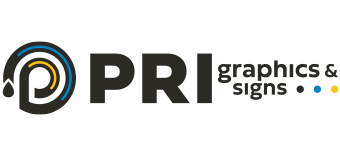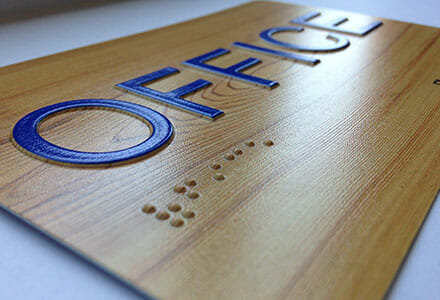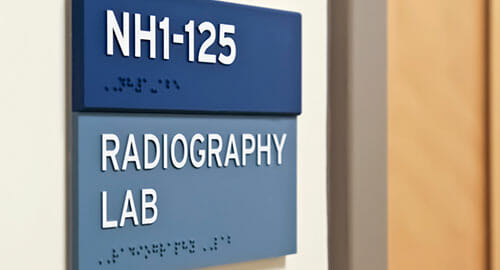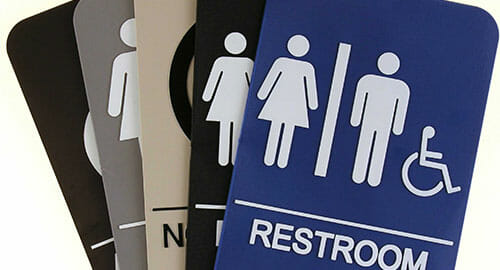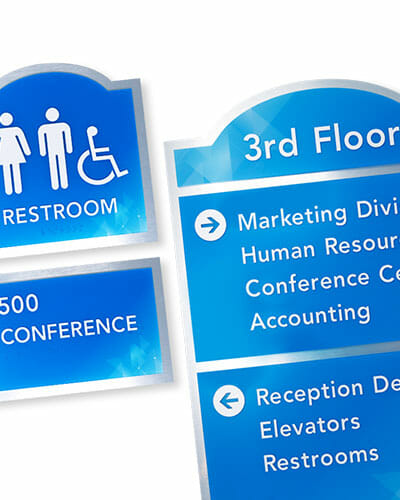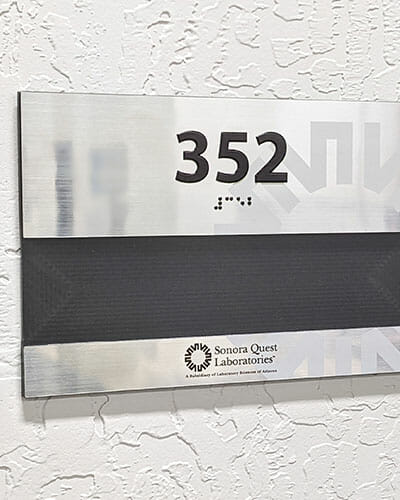ADA Signage Company – Custom ADA Compliant Signs
Braille, Disability & General ADA Signage
QUESTION: Can I have custom, code-compliant ADA signage printed and installed that matches my branding and meets legal requirements?
ANSWER: Yes. PRI Graphics & Signs in Phoenix produces in-house, fully ADA-compliant signs. ADA signage includes tactile characters with Grade 2 Braille, high-contrast non-glare surfaces, proper mounting heights (48–60″), and durable materials like acrylic or polycarbonate. We design, print, and offer installation services, including branding integration, and typically deliver within 2–4 weeks!
Builders, facility managers, and commercial property stakeholders trust our Phoenix ADA signage company to handle custom ADA signage compliant with both local regulations and the Americans with Disabilities Act (ADA).
Whether you need interior restroom identification signs or exterior parking and wayfinding markers, count on PRI Graphics & Signs to deliver custom, precision-crafted ADA signs and install them correctly on time.
Why Making ADA Signs In-House Matters
From durable substrates to pressure-sensitive adhesive and tactile lettering machines, our full-scale production shop ensures fast turnaround, consistent quality, and cost-effectiveness.
There’s no waiting for outsourcing.
Nor worrying about mismatched materials.
Everything’s done under one roof.
Need guidance on ADA compliance or installation logistics?
Email or call us anytime at (602) 393‑3131 or toll‑free (877) 409‑8889. Our ADA signage company can advise you on ADA codes, materials, and best practices every step of the way.
What Contractors & Business Owners Ask About ADA Signage
1. Where should ADA signage go?
You need elevated clarity on placement:
- Accessible bathrooms, exits, elevators, and stairwells require tactile signs inside the proper mounting range.
- Parking spots, curb ramps, and pathways need clear, visible markers that meet contrast and height specs.
- Each door with occupant information, Offices, meeting rooms, and suites all require identification signage.
Low-code practice? Our ADA signage company will partner with your specs to set signs centered 60″ from finished floor height, sized for easy tactile reading by poles or mounting devices.
2. How to make ADA signage? Which characters? Raised text or Braille?
- Use raised tactile characters at least 5⁄8″ high with 1⁄32″ stroke width.
- Required Braille is Grade 2, placed directly beneath the visual text.
- International Symbol of Accessibility pictograms must be included on signs for restrooms, elevators, exits and directional wayfinding.
3. What materials breathe longevity?
Our ADA signage company offers:
- Matte acrylic, foam board, or non-glare polycarbonate—durable, tamper-resistant, and color-stable.
- High-contrast pairs (e.g., white on navy or black on silver) that meet ADA contrast ratio requirements.
- Weatherproof coatings for UV and moisture resistance when placed outdoors.
4. How do we ensure compliance?
Our process hits every ADA bullet:
- Non-reflective matte surface.
- Lettering in all uppercase sans serif, never italics or condensed fonts.
- Approved spacing for tactile letters (3/8″ clearance top-to-bottom).
- Correct spacing between Braille dots and tactile characters.
- No exceptions – whether for public restrooms, commercial entryways, or private office doors.
5. Who handles ADA signage installation?
Our ADA signage company offers full installation services:
- Pre-punched signs, aligned to standard mounting heights.
- Permanent mechanical anchors, not tape or adhesives that may fail.
- Full consultation with your site super or facility manager to confirm placement, code clearance, and final approval.
At PRI Graphics & Signs, we specialize in printing all types of signage and understand the ADA requirements. Call us toll-free at (877) 409-8889 to request a quote.
Why Choose PRI Graphics for Your ADA Signage Company?
- Code-savvy staff – We stay current on federal, state, and local building regulations.
- Everything produced in-house ensures rapid delivery and consistency.
- Full-service installation – You provide the specs; we handle everything from drilling to leveling.
- 24/7 support: Email or call (602) 393‑3131 for quotes, design assistance, or compliance advice.
Timelines
- Standard turnaround is usually 2–4 weeks, depending on order size and customization.
- Rush orders may be available for urgent compliance needs.
- Includes design, proofing, fabrication, and optional installation.
Materials
- Acrylic – durable, sleek, and highly customizable.
- Polycarbonate – strong, lightweight, and impact-resistant.
- Photopolymer – excellent for tactile lettering and Braille.
- Metal finishes – available for upscale environments.
ADA Standards Covered
- Tactile lettering: Raised characters, sans serif fonts, proper height and spacing.
- Grade 2 Braille: Correct placement and dot spacing.
- Contrast: Light/dark backgrounds for visibility.
- Non-glare finish: Matte surfaces to avoid reflection.
- Mounting height: 48″–60″ from the floor per ADA guidelines.
Make ADA Signs Today
- Share your specs, or ask us to review your architectural or permit drawings.
- Approve the layout, font, Braille placement, and materials.
- Let us create and install your signage on schedule.
Let’s make your next ADA signage installation flawless, compliant, and brand-strong.
Get in touch via phone at (877) 409-8889 and request a custom quote and a precise timeline. With our ADA signage company expertise, your next project will be fully compliant, visually appealing, and delivered on time.
ADA Signage FAQs
What’s “Grade 2” Braille, and why does it matter?
Grade 2 Braille uses contractions and abbreviations to make signage readable and compact. Legal guidelines mandate Grade 2 in most public and commercial buildings for clarity and space efficiency.
Can ADA signage include logos or custom branding?
Yes! Our ADA signage company can integrate zero-glare logos with tactile text if your brand palette meets the required contrast against the background. Talk to us about design services that balance brand identity and ADA rules.
Do I need ADA signs in outdoor parking lots?
Definitely. Accessible parking stalls need proper signage with the wheelchair symbol, mounted at 60″ AFF above the pavement, and constructed from weatherproof material to withstand sun, ice, and rain.
How long does it take to make ADA signage and install?
For most orders, walls, doors, parking stalls, we turn things around in 5–7 business days. For large-scale projects, we coordinate phased deliveries to suit your construction schedule.
Can digital screens be ADA compliant?
Our Phoenix ADA signage company also works with clients, integrating digital kiosks and displays. Requirements include high-contrast visuals, audio narration, Braille overlays or physical placards, and proper interface height.
